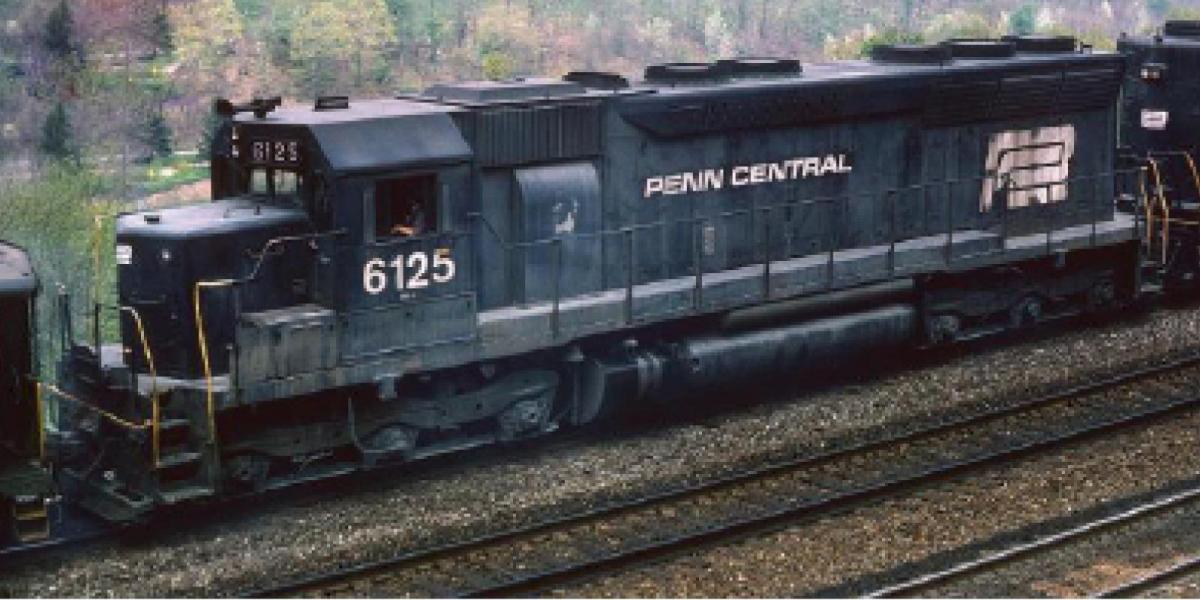An Article by Jerry Jordak – Photos by Ed Painter
As part of its ongoing battle to move trains over the Allegheny Mountains, the Pennsylvania Railroad in the mid-1960s began a shift in its motive power purchases, moving away from four-axle road power and instead to acquiring six-axle road power from the three major locomotive manufacturers. This included orders from Electro-Motive Division of General Motors that eventually numbered forty 2500-horsepower SD35s and sixty-five 3000-horsepower SD40s.
EMD introduced their 3600-horsepower SD45 in 1966. Powered by a 20-cylinder version of EMD’s 645 prime mover, it had distinctive flared radiators that set the SD45 apart from EMD’s other six-axle models. EMD advertised the SD45 as a locomotive that could “run like a racehorse and drag like a mule,” and apparently this resonated with PRR’s management in Philadelphia. Between 1966 and 1967, PRR acquired 130 of the SD45s, second only to Southern Pacific’s fleet (317) out of the SD45s original owners. These were numbered 6105-6234, right after PRR’s SD40s.

Pennsylvania and New York Central merged to form Penn Central on February 1, 1968, and the entire PRR fleet of SD45s became PC property and retained their PRR numbers. Over the next eight years, many of these locomotives would be repainted into Penn Central black with white lettering. Five were painted with the short-lived “red P” emblem that was used between April and June 1968. These locomotives could be found all over the system, both in heavy drag and high-speed service, but as time went on PC tended to use them more on high-speed merchandise and piggyback trains where their extra horsepower would be better utilized.
The SD45 was known for having crankshaft problems and high fuel consumption, which may explain why Penn Central only acquired an additional five SD45s. Ordered by PRR before the merger, they were numbered 6235-6239 and were built by EMD in August 1968. (By comparison, PC would acquire an additional forty-five SD40s in 1970 and 1971.) Penn Central’s SD45 fleet would eventually be conveyed to Conrail on April 1, 1976, keeping their same numbers until retirement in the early to mid-1980s. Most of Conrail’s SD45s were scrapped, but a group of them were sold to Chicago & North Western in 1983. Some of these were later rebuilt as SD40M-2s (with 16-cylinder 645 prime movers) and were used in lease service by Morrison-Knudsen, VMV, and Helm Leasing.

My interest in Penn Central goes back to my high school years when I first got my hands on a copy of a book by Robert Yanosey titled Penn Central Power. I was amazed by the wide variety of locomotives that Penn Central had, including some locomotive models that I never knew existed! This led me to a life-long interest in Penn Central, and I began to collect PC paperwork and other information and learn more about this short-lived railroad. I came to appreciate not only the extensive reach of the PC system (from high-speed mainlines to weed-covered rural branches), but also its place in the timeline of railroad history. It was a time of transition, where you had elements of “classic” railroading, like towers and manned depots with agents, first-generation locomotives, and 40-foot boxcars, along with elements of “modern” railroading, such as high-horsepower locomotives (like SD45s), hi-cube boxcars, autoracks, and piggyback service. Eventually, I helped with the founding of the Penn Central Railroad Historical Society in 1999 and have been a trustee ever since. (I guess you could say I was a Penn Central fan before it was “cool.”)
As an HO scale Penn Central modeler, I am excited about the new run of PC SD45s from ScaleTrains.com. While to date I only own one of their models (a Trailer Train F68AH bulkhead flatcar), I have seen their tunnel motors and ES44ACs in person, and the level of detail is amazing, as is the sound from ESU’s LokSound decoders. My layout is set in the steel-making region of the Mahoning and Shenango River valleys of western Pennsylvania, and I run lots of heavy coal and ore trains, along with a few priority freight trains, both of which are well-suited for an SD45. All of this means I will soon be ordering my first ScaleTrains.com locomotive, and I am sure many other PC modelers will too. I also invite PC modelers and fans to check out the Penn Central Railroad Historical Society at www.pcrrhs.org.












